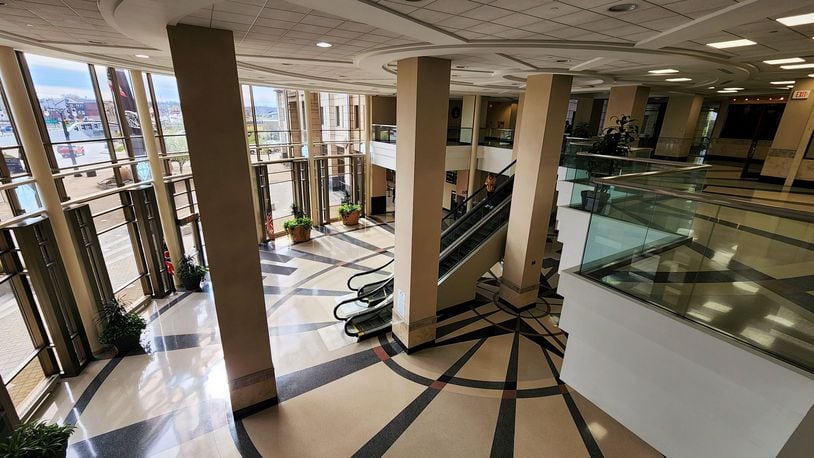“The second S would be space utilization and needs of independent offices and departments, identifying what their true needs are, as we begin to right-size Butler County government and also look at our operations and interactions with the taxpayers,” she said.
“The third S would be synergies, how are we identifying the ability for the offices that have like uses or the need to collaborate to best serve the taxpayer, we’re going to be looking at those synergies and making some recommendations.”
The county embarked on this project several years ago, but it stalled when former asset director Randy Quisenberry left. Back then they discussed relocating the auditor, recorder and treasurer under one roof because people often need all three of their services at once. Treasurer Nancy Nix is housed in the Government Services Center while the other two offices are in the annex building a few blocks down on High Street. The development and water and sewer departments also housed in the annex.
Commissioners Don Dixon and T.C. Rogers both say they obviously won’t know for sure until the study is complete, but they believe they can discard that building and make “millions” selling it.
“I’m thinking we could possibly end up emptying the 130 building down across from the courthouse, the old administration building for one,” Dixon said. “That could go on the market and be worth several million dollars.”
Rogers agreed, saying given the fact Hamilton is making great strides repurposing old buildings with new uses, selling it would be best if they can.
“Given the present economic climate I think that is more valuable with the development going on in Hamilton,” he said.
Butler County Recorder Danny Crank met with the CBRE consultants Wednesday and he said he told them he is willing to move but a new location has to have weight bearing floors to hold all of his books, unless the commissioners agree to give him an estimated $700,000 to scan them. He also need to be accessible to the public and it is imperative he is officed near the county auditor because people usually need both their services simultaneously.
“I’m happy to move if it helps the county financially,” Crank said. “My issue is a place for my books, give me the money to scan them then there’s no issue. And make sure we’re somewhere close to the auditor, that’s my issues.”
Thus far there haven’t been any talks about other potential moves. There are separate buildings for the Board of Elections, Children Services, Developmental Disabilities, Care Facility, county engineer, health department, the Juvenile Justice System, the Mental Health and Addiction Recovery Services Board, the morgue, OhioMeansJobs and the Probate and Area Courts. The sheriff’s office also has three jail facilities and the dispatch center.
The county needs many of these separate facilities and there is not room in the Government Services Center for everything.
Mary Dungan, a client strategy and consulting manager for CBRE met with the commissioners this week to explain how they will undertake the task. Rogers asked her if they have ever told a client no changes are needed, she said no. Then he asked if they’ve ever “told the client they should sell everything and just build new.”
“Yes, we do try to be extremely, extremely customized to the client, in that scenario it’s typically an efficiency perspective so with the majority of our engagements right now post-COVID, is how are we efficient with our space, when people are working in a little bit different way,” Dungan said. “So we do make those recommendations sometimes and usually it’s from a cost perspective that makes the most sense.”
Commissioner Cindy Carpenter acknowledged everyone worked differently when they built the GSC in 1998 and there are some drawbacks from some of the prior decisions. For example they located high traffic offices like Job and Family Services on the eighth floor “therefore we’ve paid for an enormous amount of elevators repairs.”
She also asked her to make sure the other office holders are happy with what they suggest or “we’re going to be faced with office holders saying or she got more, and he got more, I’m kind of concerned about that because that was a battle we had when we moved into this building.”.
“That’s where we bring in the benchmarks, it is where we’ve found clients we’ve worked with in the past is where we say here’s a benchmark, here’s what 98% of public sector clients are in this range, it’s a little bit easier on the change management aspect when we start to implement those,” Dungan said. “People like their space so we use that as more of a persuasion tactic to say this is what the market is.”
The entire process should take about three months and the commissioners have a $15 million capital reserve budget they can tap to implement any changes. Dixon said he wants to be updated as the process proceeds.
“I don’t want to get to the end and you lay out a plan and we say ack,” Dixon said. “Because we want to make sure the office holders are hand-in-hand with this as we go through it. We’re not going to make decisions for them, we need their input so we can bring this together. I don’t want to get so far down the road that you’re doing some things we’re definitely not in favor of.”
About the Author
